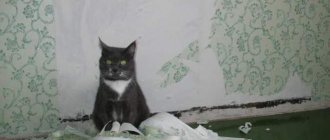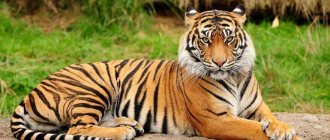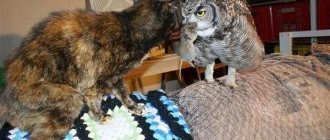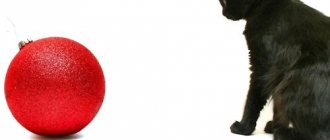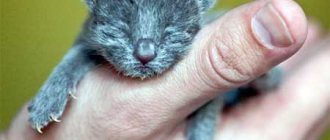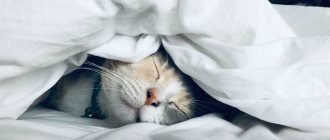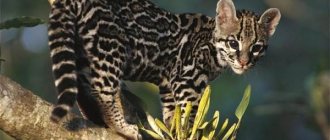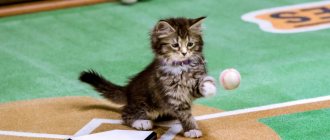How did miniature cats appear?
In recent decades, cats have ceased to be considered as indispensable assistants in the fight against rodents. Therefore, for more than 30 years, the breeding activities of felinologists have been aimed at breeding ornamental breeds with exclusive external characteristics. And since ordinary people have become fashionable for miniature animals, many dwarf varieties have been created in recent years.
Almost all small cats are the result of hybridization or gene mutation. Therefore, it is not surprising that dwarf varieties have many disadvantages, the main ones of which are:
- little knowledge of hereditary diseases;
- limited gene pool;
- instability.
The smallest cat breeds in the world
The top 10 dwarf varieties include small animals whose weight does not exceed 4 kg:
- skiff-tay-don (dwarf bobtail);
- munchkin;
- Napoleon;
- bambino;
- Lamkin;
- Skookum;
- Dwelf;
- Singapura cat (Singapura);
- minskin;
- kinkalow.
Skif-tay-don (dwarf bobtail)
These beautiful little cats are the result of a specific gene mutation in the Mekong Bobtail. They are distinguished by their dwarf size and unusual Siamese color, in harmony with the bright blue color of their eyes.
An adult Scythian Tay-Don weighs between 0.9-1.5 kg and looks like a four-month-old kitten of an ordinary medium-sized breed. And the main feature of the dwarf bobtail is its short tail, similar to a pompom.
Munchkin
These dwarf cats appeared as a result of a natural genetic mutation, and not as a result of selective breeding. Munchkins have a long body and short legs, giving them a dachshund-like appearance.
As adults, their body weight is 2-3 kg, which gives them every right to claim the title of the smallest cat breed.
Interesting! A munchkin cat named Liliput is listed in the Guinness Book of Records. The height of the dwarf animal was only 13.34 cm.
Napoleon
Munchkins and Persians took part in the formation of this dwarf cat breed. Therefore, it is not surprising that they are distinguished by their unique appearance and small size.
These small cats are easily identified by their fluffy coat, large, wide-set eyes and short legs. The weight of an adult representative of the breed is 2.5-4 kg.
Bambino
These dwarf cats are descended from Munchkins and Sphynx cats. It is not surprising that with such ancestors, bambinos inherited an exotic appearance. The Sphinx gave the small cats hairless skin and a long, whip-like tail.
Bambino munchkins gave them short legs and miniature size. As adults, hairless mini cats weigh between 2-4 kg.
Lamkin
These cute dwarf cats are descended from the Selkirk Rex and the Munchkin. From the first they inherited curly hair. The latter gave the lambkins light weight and short legs. Cute little cats grow up to 22-25 cm at the withers and weigh about 2.5-4 kg.
Skookum
This relatively young breed of the smallest cats appeared as a result of the work of American breeders. Laperms, who gave them fluffy wavy hair, and munchkins, who gave them short limbs and small dimensions, took part in the formation of skookums.
An adult cat of this breed weighs between 3-4 kg.
Dwelf
These contenders for the right to be called the smallest cats appeared as a result of crossing Sphynxes, American Curls and Munchkins. Adult Dwelfs weigh about 1.5-3 kg. But the main distinguishing feature of unusual small cats is their large, backward-curved ears.
Singapura cat (Singapura)
These oriental beauties with expressive almond-shaped eyes and graceful muzzle weigh no more than 3 kg. The Singaporean ancestors of these cats lived in manholes and gutters and remained unnoticed by the local population for a long time.
They became famous only when American breeders became interested in them. Now these small cats are considered the mascot of the island.
Minskin
This little cat is a cross between a Sphynx and a Munchkin. She weighs only 2-3 kg and has almost bald skin. Only sparse hairs grow on the Minskin's paws.
Kinkaloe
This short-legged dwarf cat with a funny face and curled ears weighs less than 3 kg. He has very difficult genetics and is difficult to breed. It often happens that out of the entire litter, only 1-2 kittens have all the characteristics of a “purebred” Kinkaloo.
Therefore, this breed of dwarf cats is considered very rare and costs a lot of money.
Minskin: 1.8 – 2.7 kg
Minskin
Another miniature hairless breed that was bred in the States. The gene pool is based on two breeds: Canadian Sphynxes and Munchkins. Representatives of the Minskins are distinguished by a well-built body and small height - their height does not exceed 19 cm . The miniature size is compensated by the endless curiosity, sociability and tenderness of these creatures.
Interesting: How do animals eat in space? Description, photo and video
Other small breeds
There are other types of cats, differing in their miniature dimensions.
American Curl
This small cat weighs no more than 4.5 kg. He has a remarkable appearance and a playful, good-natured disposition. All American Curl kittens are born with straight ears, but after a few days they begin to curl back.
Devon Rex
This small cat has a graceful physique and a memorable appearance. The Devon Rex is easy to recognize by its large, expressive eyes, huge splayed ears and short, curled mustache.
As an adult, he weighs no more than 4.5 kg and can compete for the title of smallest cat.
Balinese cat
Representatives of the breed have slender, graceful bodies, shiny coats and fluffy tails. Graceful little cats weigh no more than 4 kg and look like Siamese, only with long hair.
Abyssinian cat
Thoroughbred Abyssinians are distinguished by their active temperament and graceful physique. These narcissistic, small, graceful cats weigh no more than 4.5 kg. And their toned bodies are covered with a luxurious shiny fur coat of wild, fawn, red or blue color.
Skookum
Photo: Instagram/alfiemunchie
These cats were bred artificially in the United States of America. Their creator wanted to breed not only the smallest cat in the world, but also the curliest one. Translated from Indian, the name of the breed translates as “strong, brave.” Their distinctive feature is their wavy and long coat. On average, the weight of an adult reaches 3.6 kilograms.
Crumbs from the Guinness Book of Records
The record holder among miniature animals is a tabby cat named Mr. Pibbles. He lives in one of the veterinary clinics and has no owners. At 2 years old, the pocket cat weighed only 1.3 kg and its body length was 15 cm.
Experts suggest that he stopped growing due to an irreversible genetic failure that occurred in infancy.
Another baby from the pages of the Guinness Book of Records - Tinker Toy. The little native of the American state of Illinois weighed only 700 g with a height of 7 cm and a body length of 19 cm.
From 7 to 12 months
The following can be said about the “teenage” stage of development of the Siberian breed:
- 7 months. The animal reaches sexual maturity - it’s time to think about sterilization or castration. The first molt occurs.
- 8 months. The most optimal time for castration or sterilization.
- 10 months. Animals can ask for a “date”, but they should not be bred until they are one year old. 10-month-old Siberians participate in exhibitions along with adult cats.
- 11 months. The beast practically stops growing. The cat is transferred to adult food, the number of meals is reduced to 2-3 per day.
- 12 months. The Siberian is already an adult animal. But it will continue to develop until 2-2.5 years.
Photos of 9-month-old animals:
Siberian cats at 1 year:
The smallest cat in the world of wildlife
Dwarf varieties exist not only among artificially bred breeds, but also among wild representatives of the cat family:
- Kalimantan cats. These animals weigh about 2.3-4.5 kg and live in Malaysia and Indonesia. Wild small cats avoid meeting people and rarely get caught on camera.
- Dune cats. These inhabitants of rocky valleys and deserts are carnivorous and nocturnal. Predatory small cats weigh no more than 3-3.5 kg.
- "Rusty" cats. Dwarf owners of a spotted gray-red-brown coat have a body weight of 1.5 to 2 kg. Wild small cats are an endangered species and are found in southeastern India and Sri Lanka.
- Codecode. These dwarf inhabitants of Chile and Argentina are also called Chilean cats. They grow no more than 22 cm at the withers and weigh between 1.5-3 kg.
- Black-footed cats. The average weight of these animals does not exceed 1.8 kg with a height of up to 20 cm at the withers. Agile small cats have lightning-fast reactions and a developed hunting instinct. In the wild, they are skilled at catching birds and rodents, but in captivity they become very aggressive.
Small cats captivate at first sight with their touchingly defenseless appearance and are becoming more and more popular every year. Therefore, it is likely that the list of dwarf breeds will soon be replenished with new varieties.
Kitten at birth
A newborn Siberian kitten is completely helpless: it cannot see or hear, and cannot regulate the temperature of its own body. The baby's fur is so thin that it does not warm him at all. The animal cannot stand on its paws, it needs to be taken care of - the bones are still very fragile.
The little ones only sleep and eat - in the first week they spend up to 22 hours a day in the “kingdom of Morpheus”. Sleep is necessary for the harmonious development of the nervous system. Babies have already developed a sense of smell and touch; they massage their mother’s nipples with their paws, stimulating milk production. The cat not only washes and licks them, but also eats the feces of the offspring.
The owner closely monitors the baby's weight gain: a healthy kitten gains 10-20 g daily. In the first week, the following happens:
- 1-2 days: the offspring only sleeps and sucks milk.
- 3-4 days: the kittens' umbilical cord falls off and heals.
- 4-5 days: babies begin to respond to sounds.
- Days 6-7: babies move more, their ears noticeably open. Also, the animals may already begin to develop eyes.
So, by the end of the first week of development:
- The paws become stronger.
- The kitten sleeps less.
- The fur gradually becomes fluffy, and the first undercoat appears.
- The brood begins to actively crawl around the box.
Photos and videos of Siberian kittens after birth:

